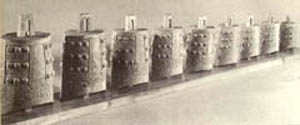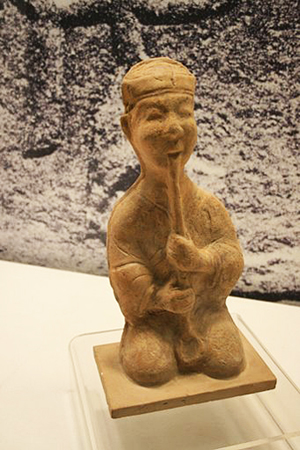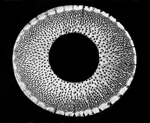|
Chronology
CHINA 1 • 6000 BCE to 500 CE
6000 BCE or even older? - THE OLDEST PLAYABLE FLUTES in the WORLD

Ancient bone flutes excavated at Jiahu, Henan Province,
Central China, in 1986.
The Jiahu site was inhabited between 7.000 and 5.700 BCE approx.
Read more about these remarkable old musical instruments here:
Brookhaven National Laboratory: Bone Flute Found in China
Shakuhachi.com: Article in Nature Magazine 1999
Wikipedia.org: Gudi (instrument)
Icobase: Flutes Aerophones
Listen to sound samples here:
Brookhaven National Laboratory: Wav file 1 (4.2 MB)
Erik the Flute Maker
YIN-YANG, WU-HSING, TAOISM, CONFUCIANISM
& THE CHINESE SCIENCE OF SOUND
6th CENTURY BCE:

氣 /
気
- CH'I / QI - 2nd tone - (Japanese: KI)
Breath; Air; Vital Vapour; Steam; Energy; Essence; Spirit; Mind; Soul; Intention; Heart ...
"In breathing one must proceed as follows:
One holds the breath and it is collected together.
If it is collected it expands.
When it expands it goes down.
When it goes down it becomes quiet.
When is becomes quiet it will solidify.
When it becomes solidifed it will begin to sprout.
After it has sprouted it will grow.
As it grows it will be pulled back again (to the upper regions).
When it has been pulled back it will reach the crown of the head.
Above, it will press against the crown of the head. Below it will press downwards.
Whoever follows this will live; whoever acts contrary to it will die."
"Chinese inscription on twelve pieces of jade, which may have
formed part of the knob of a staff. Date: certainly Chou, may be
as early as the middle of the -6th century."
Trsl. by Joseph Needham, 1962.

Nine bronze bells tuned in scale
Height from 28,0 to 16,6 cm
First quarter of the 5th century BCE
5th century BCE:
六氣
天有六氣
降生五味
發為五色
徵為五聲
"There are the six ch'i of Heaven.
Their incorporation produces the five flavours;
their blossoming makes the five colours;
they proclaim themselves in the five notes."
Quoted from the Tso Chuan, 5th century BCE
Trsl. by Joseph Needham, 1962.
Link: http://ctext.org/chun-qiu-zuo-zhuan?searchu=%E5%85%AD%E6%B0%A3
433 BCE

Set of 65 'bian-zhong' (bronze bells) from the Tomb of Marquis Yi of Zeng in Suizhou, Hubei, China, dated 433 BCE
6th-5th CENTURY BCE:
TAO TE CHING:
無爲 - WU WEI - "Non-action"/"Non-effort"
6th-5th CENTURY BCE:
五色令人目盲,
五音令人耳聾,
五味令人口爽.
Colour's five hues from the eyes their sight will take;
Music's five notes the ears as deaf can make;
The flavours five deprive the mouth of taste.
Lao Tzu in Tao Te Ching, 6th century BCE
Trsl. by James Legge, 1961. Link: http://ctext.org/dao-de-jing
c. 300 BCE:
且夫失性有五
一曰五色亂目,使目不明
二曰五聲亂耳,使耳不聰
三曰五臭薰鼻,困惾中顙
四曰五味濁口,使口厲爽
五曰趣舍滑心,使性飛揚。
此五者,皆生之害也。
"Now there are five things which produce (in men) the loss of their (proper) nature.
The first is (their fondness for) the five colours, which disorder the eye, and take from it its (proper) clearness of vision;
the second is (their fondness for) the five notes (of music), which disorder the ear and take from it its (proper) power of hearing;
the third is (their fondness for) the five odeurs which penetrate the nostrils, and produce a feeling of distress all over the forehead;
the fourth is (their fondness for) for the five flavours, which deaden the mouth, and pervert its sense of taste;
the fifth is their preferences and dislikes, which unsettle the mind, and cause the nature to go flying about.
These five things are all injurious to the life ... "
Chuang Tzu, c. 369-286 BCE, in the Chuang Tzu, c. 300 BCE
Trsl. by James Legge, 1961. Link: http://ctext.org/zhuangzi/heaven-and-earth
a. 300 BCE:
荃者所以在魚,得魚而忘荃
蹄者所以在兔,得兔而忘蹄
言者所以在意,得意而忘言。
吾安得忘言之人而與之言哉?
Fishing-stakes are employed to catch fish;
but when the fish are got, the men forget the stakes.
Snares are employed to catch hares, but when the hares are got,
men forget the snares.
Words are employed to convey ideas;
but when the ideas are apprehended, men forget the words.
Fain would I talk with such a man who has forgot the words!
Chuang Tzu, c. 369-286 BCE, in the Chuang Tzu, c. 300 BCE
Trsl. by James Legge, 1961.
Link: http://ctext.org/zhuangzi/what-comes-from-without
"A basket-trap is for catching fish,
but when one has got the fish,
one need think no more about the basket.
A foot-trap is for catching hares;
but when one has got the hare,
one need think no more about the trap.
Words are for holding ideas,
but when one has got the idea,
one need no longer think about the words.
If only I could find someone who has stopped thinking about words and could have him with me to talk to!"
Chuang Tzu, c. 369-286 BCE, in the Chuang Tzu, Ch. 26, c. 300 BCE
Trsl. by Fung Yu-lan, 1948, 1968.
"The fish trap exists because of the fish; once you've gotten the fish, you can forget the trap.
The rabbit snare exists because of the rabbit; once you've gotten the rabbit, you can forget the snare.
Words exist because of meaning; once you've gotten the meaning, you can forget the words.
Where can I find a man who has forgotten words so I can have a word with him?"
Chuang Tzu, c. 369-286 BCE, in the Chuang Tzu, Ch. 26, c. 300 BCE
Trsl. by Burton Watson. Link: http://terebess.hu/english/chuangtzu.html
"If Earth pipes, it is with all its apertures. If Man pipes, it is with the collected bamboos."
- - -
"Even the most skillful zither player, if he strikes the shang note he destroys the chio note, if he vibrates the kung note he neglects the chih
note. It is better not to strike them at all; then the five notes are complete in themselves."
Chuang Tzu, c. 369-286 BCE, in the Chuang Tzu, c. 300 BCE
Trsl. by Joseph Needham, 1962.
"Anciently, Huang Ti ordered Ling Lun to make pitch-pipes. So Ling Lun, passing through Ta-Hsia towards the west, travelled to the northern slopes of the Juan-yü mountains,
and there in the valley of Hsieh-ch'i found bamboos with stems of which the hollow (part) and the thickness (of the walls) were uniform.
Cutting one between the the nodes to a length of 3:9 in., he blew it, and took its fundamental note [kung] to be that of the Huang-chung tube.
Blowing again, he said, 'This is good enough', and proceeded to make all the twelve pipes [t'ung].
Then at the foot of the Juan-yü mountain, he listened to the singing of the male and female phoenix and divided the pitch-pipes accordingly (into two groups),
the male notes making six and the female also six. In order to bring them together, the Huang-chung fundamental harmonised them.
Indeed the Huang-chung fundamental [kung] is capable of generating the entire (series).
Therefore it is said that the Huang-chung fundamental is the source and root of the male and female pitch-pipes [lü-lü].
(Upon his return) Ling Lun, together with Jung Chiang, was ordered by Huang Ti to cast twelve bells in order to harmonise the five notes, so that splendid music might be made. - - - "
Quoted from the Lü Shih Ch'un Ch'iu, 239 BCE, by Lü-pu-wei, n.d.
Trsl. by Joseph Needham, 1962.
(Joseph Needham comments: "This is of great interest as showing that
all the other musical instruments were to be tuned in accordance with
the pitch of the five notes emitted by the unaltering standard bells.")
Ca. 180 BCE:

Set of 12 Chinese pitch pipes dated a. 180 BCE found at a famous, very significant burial site
at Ma-wang-tui, No. 3 Tomb, near Ch'ang-sha in Hunan Province, China.
Picture from a special edition of the archaeological magazine Wen Wu, September, 1972.
I has to be noted that the 12 pitch pipes shown were apparently manufactured to be part
of a special Chinese Han Period type of mouth organ, namely the 'yu',
竽.
2nd CENTURY BCE:
"Try tuning musical instruments such as the ch'in or the se. The kung note or the shang note struck upon one lute will be answered by the kung
or the shang notes from other stringed instruments. They sound by themselves. This is nothing miraculous, but the Five Notes being in relation;
they are what they are according to the numbers (whereby the world is constructed)."
Tung Chung-shu, 2nd century BCE Trsl. by Joseph Needham, 1962.

Chinese 'se' zither used in the ritual music of Ancient China
Excavated at Ma-wang-tui, Eastern Hunan Province
Date: c. 180 BCE (Western Han Period).
"When the human world is well governed and the people are at peace, when the will (of the ruler) is equable and his character correct,
then the transforming (influences) of Heaven and Earth operate in a perfect manner, and among the ten thousand things only the finest are produced.
But when the human world is in disorder and the people become perverse, or when the will (of the ruler) is depraved and his character rebellious,
then (their) ch'i opposes the transforming (influences) of Heaven and Earth, harming the ch'i (of Yin and Yang) and so generating calamities and disasters."
Tung Chung-shu, 2nd century BCE, in the Ch'un Ch'iu Fan Lu.
Trsl. by Joseph Needham, 1962.
1st CENTURY BCE:
" --- When numbers assume form, they realise themselves in musical sound."
Ssu-ma Ch'ien, 145-86 BCE, in the Shi Chi,
compiled 109-91 BCE
Trsl. by Joseph Needham, 1962.
1st-2nd CENTURIES CE

Ceramic figurine of a musician playing a 'xiao' ('hsiao') vertical flute,
from the Pengshan Tomb of Sichuan, China
Eastern Han Dynasty, 25-220 CE, Nanjing Museum, China
2nd CENTURY CE:
"In determining the pitch of bells in antiquity they levelled off their notes by ear.
After that when they could go no further they availed themselves of numbers
and thereby made their measurements correct.
If the figures of the measurements are correct the notes will also be correct."
Ts'ai Yung, 133-192 CE, commenting on the Yüeh Ling.
Trsl. by Joseph Needham, 1962.
3rd CENTURY CE:
" (The opening bars of a lute melody are) strong like lofty mountains, or again they resemble heaving waves: broad and generous, majestic and imposing.
Then the tones become more irregular, halting as if in sorrow, and dragging on like rustling garments.
Then again the melody expands, tones rise as bubbling waves, they open up like blossoming flowers.
Having understood the style of the melody, one must observe the rhythm, correctly reproducing the various transitions in tempo, but keeping the right measure.
One must shun specious effects, and concentrate on one's play, abiding by the rules, playing on quietly.
Then the tones shall be imposing and expressive, they spread out, vastly expansive. Distinctly and clearly they end,
and finally the coda in 'floating tones' echoes faintly the main motif of the melody."
Quoted from the Ch'in-fu, 'Poetical Essay on the Lute', by the
Confucian scholar-gentleman Hsi K'ang, 223-263 CE
Trsl. by R.H. van Gulik, 1941, 1969.

Chinese 'ch'in' zither
A treasure of the Hōryū-ji, Nara, Japan. T'ang Period
4th CENTURY CE
"The ch'i associated with wind being correct, the ch'i for each of the twelve months (causes) a sympathetic reaction [ying] (in the pitch-pipes);
the pitch-pipes (related serially to the months) never go astray in their serial order."
Ch'en Tsan, 4th century CE, commenting on the Ch'ien Han Shu.
Trsl. by Joseph Needham, 1962.
5th CENTURY CE:
"The symbol serves to express an idea,
and it is to be discarded once the idea has been understood.
Words serve to explain thought,
and ought to be silenced once the thoughts have been absorbed.
- - -
It is only those who can grasp the fish
and discard the fishing net
that are qualified to seek the truth."
Tao-sheng, d. 434 CE Trsl. by Fung Yu-lan, 1948, 1968.
T.O. comment: Tao-sheng studied Buddhism with Kumarajiva,
344-413, but was also strongly influenced by Taoism. The above
statement of his refers to a saying in the Chuang Tzu,
see above.
T'ang Dynasty, 7th-10th centuries CE:
"Above every enemy in battle there exists a vapour-colour [ch'i-se].
If the ch'i is strong, the sound (note) is strong. If the note is strong, his host is unyielding.
The pitch-pipe is (the instrument) by which one canalizes (or communicates with) ch'i, and thus may foreknow good or evil fortune."
Ssu-ma Chen, T'ang Dynasty, 618-906 CE, commenting on the
Ping Shu, 'Book of War', now lost. Trsl. by Joseph Needham, 1962.
|
|








